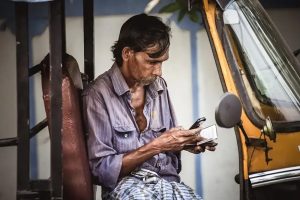Catalysts to Accelerate Financial Inclusion

November was marked by the world waiting to see the results of American elections. For us, it was a month of optimising a different kind of polling. Our surveys underwent three iterations over the course of the month and are now finalised for distribution to over 4000 individuals in the coming months. The key change that occurred since our previous post was a change in focus on target demographics. We had initially decided to look at gig economy workers across geographies and skill-spectrums. However, as the first batch of data came in, it became quite clear that we will have to streamline our focus on specific target-groups as responses varied extremely wide depending on who we spoke to. Since then, we shifted the geo-locations and individuals being surveyed to focus on individuals who are at the periphery of “digital” India. These are primarily individuals who have access to mobile devices, engage with the gig economy via apps and have moved to cities in the recent past.
In addition to changes in the survey and target demographic, there are three key observations we made over the course of the month. Each of these were the result of conversations we have had via Bharat Inclusion Research Fellowship (BIRF) and individuals we have surveyed for the purpose of our study.
1. The Rise of Humans as an API layer
In arranging for our data-collection initiatives, we noticed that some of our partner organisations are able to conduct tasks in remote parts of the country through a strong, well-trained network of individuals: ones who are positioned to carry out tasks for business to consumer firms. The most reliable among these were MIMO technologies. In our conversation with the founder (Lathika), we observed that financial inclusion on its own is only a tool. In order to be truly transformative, labor needs to be on-boarded to digital platforms, trained and enabled to create a track record of interactions. These interactions should ideally be exportable and verifiable by third parties according to the model we are pursuing. While individual firms may find it costly to be able to hire individuals in remote regions, platforms like MIMO split the work of multiple firms to partners on-ground. This in exchange reduces the cost component for each participating venture.
2. Parallelized Innovation
A large share of our study focuses on the need to digitise transactions and skills-related data. However, communicating with others in the industry has gradually revealed that the release of a tech-stack alone does not change consumer behavior. It requires parallel changes in the industry. One instance of this is UPI. While the payments protocol has been critical in enabling the movement of money within the country, the rise in the number of individuals with a mobile connection, banking access and reduction in internet costs accelerated its adoption. We see a similar pattern when speaking to partner organisations like ICAAP (international Cooperative Alliance) who have already laid the ground-work for the digital tools we are creating to be integrated. For financial inclusion to occur at scale, we will need to enable a skill identity application modeled for overall well being in a digitisation environment and open-data ecosystem with incentives for data cooperation to all occur parallely at scale. More on parallelized innovation can be read from prominent research analyst and economist — Bryan Hobart’s post here.
3. Communities as moats
Multiple organisations that we have been engaging with focus on building a network of users that are engaged with their product. Part of the reason for this is the reduction of cost that comes with a community member being able to guide a new user instead of a centralised staff. In addition, having a network of users brings much needed credibility to the platform without the need to spend additional marketing dollars. In Finance — we see this playing out in the case of Grameen Bank and Kerala based Kudumbashree. Alternative lending platforms like Arboreum try to include the community when it comes to providing financial services as the loss of reputation that comes from being a user that misuses the system dissuades the individual from being a bad player.
Over the next two months, data should be coming in from eight cities of the country through two different data-sourcing partners. We will also be collaborating with ICAAP on their coopathon — an initiative focused on helping cooperatives go digital. We have been slowly learning — while the data collection itself can give us a quantitative interface to understanding markets, it is the stories and in-market insights we gather through experts building these platforms that help us connect the dots.
This research was developed as part of the Bharat Inclusion Research Fellowship.
